arkoma
Redneck Overlord
      
Posts: 1763
Registered: 3-2-2014
Location: On a Big Blue Marble hurtling through space
Member Is Offline
Mood: украї́нська
|
|
Parrot Guano
I hesitate to post because I am so disorganized.
We've got a Amazon parrot here. Lots of poop. I know its full of nitrates phosphates, etc but I'm not sure how I'd separate them. Already
determined not all are water soluble. (my roomate thinks I'm CRAZY).
I've got some basic reagents here to work with:
dimethyl ketone
HCl
NaOH
Salted out IPA
Thanx. Arky
|
|
|
gdflp
Super Moderator
      
Posts: 1320
Registered: 14-2-2014
Location: NY, USA
Member Is Offline
Mood: Staring at code
|
|
It's very unlikely that you will be able to separate insoluble phosphates from the cellulose base, and the nitrates which you may or may not be able
to extract are going to be heavily contaminated with other anions and cations. If you are trying to do this to save money, it will be MUCH cheaper to
buy anything you want. If you are doing it to see if you can, trust me it will be a long, shitty(metaphorically and physically) process.
|
|
|
arkoma
Redneck Overlord
      
Posts: 1763
Registered: 3-2-2014
Location: On a Big Blue Marble hurtling through space
Member Is Offline
Mood: украї́нська
|
|
No, it's strictly out of curiosity.
I've been having a ball (intellectually) since I found sciencemadness.
|
|
|
NexusDNA
Hazard to Others
  
Posts: 104
Registered: 23-11-2013
Location: Brazil, under an umbrella
Member Is Offline
Mood: Liberated from cocoon
|
|
You'll probably find about this sort of thing on literature like anarchist's cookbook, I suppose, hahaha.
It may be somewhat usable for pyrothecnics, but I doubt one can make something useful for reactions out of it.
|
|
|
arkoma
Redneck Overlord
      
Posts: 1763
Registered: 3-2-2014
Location: On a Big Blue Marble hurtling through space
Member Is Offline
Mood: украї́нська
|
|
anarchists cookbook? LOL. Not after "kewl" stuff m8.
|
|
|
cyanureeves
National Hazard
   
Posts: 744
Registered: 29-8-2010
Location: Mars
Member Is Offline
Mood: No Mood
|
|
i tried to distill nitrates from bird poop scraped from my bird bath without success.the bird poop stunk like urine and was bright red but the birds
probably appreciated me for cleaning their water supply.
|
|
|
arkoma
Redneck Overlord
      
Posts: 1763
Registered: 3-2-2014
Location: On a Big Blue Marble hurtling through space
Member Is Offline
Mood: украї́нська
|
|
This "crap" gives a pretty green solution when extracted with water and after filtration and a bit of heating I'm getting a grayish precipitate. And
for everyone's FYI I went through the pyro thing at 15 and the drug thing in my 20's; I'm now 50 and CURIOUS with time on my hands (semi-retired).
|
|
|
NexusDNA
Hazard to Others
  
Posts: 104
Registered: 23-11-2013
Location: Brazil, under an umbrella
Member Is Offline
Mood: Liberated from cocoon
|
|
Sorry if I sounded like a "no-help-the-cooks-and-kewls", it wasn't my intention. I find learning chemistry through drugs and explosives very amusing.

But... there are less unsavory things to experiment than bird droppings. Unless you give the parrot a very rich nitrate diet, the proccess of
isolating compounds will be slow and painful.
|
|
|
arkoma
Redneck Overlord
      
Posts: 1763
Registered: 3-2-2014
Location: On a Big Blue Marble hurtling through space
Member Is Offline
Mood: украї́нська
|
|
Thanx. I'm old enough to have legally purchased l-eph and HI once upon a time (RJM Labs, Santee, CA)
I really am interested in what i can get out of "Bailey poo", even if only in centigram quantities.
|
|
|
Mildronate
Hazard to Others
  
Posts: 428
Registered: 12-9-2009
Member Is Offline
Mood: Ruido sintetico
|
|
Guys you are crazy 
|
|
|
blogfast25
International Hazard
    
Posts: 10562
Registered: 3-2-2008
Location: Neverland
Member Is Offline
Mood: No Mood
|
|
The nitrate content in guano is generally low. Good enough for manure but not much else.
Why not try simply to dry and grind it finely, then leach with boiling hot water? Filter to clear and evaporate filtrate to dryness and investigate
what you've got?
|
|
|
Mildronate
Hazard to Others
  
Posts: 428
Registered: 12-9-2009
Member Is Offline
Mood: Ruido sintetico
|
|
There was procedure for this in improvised munitions handbooks (or something like that)
|
|
|
arkoma
Redneck Overlord
      
Posts: 1763
Registered: 3-2-2014
Location: On a Big Blue Marble hurtling through space
Member Is Offline
Mood: украї́нська
|
|
Quote: Originally posted by blogfast25  | | Why not try simply to dry and grind it finely, then leach with boiling hot water? Filter to clear and evaporate filtrate to dryness and investigate
what you've got? |
What I have done at the moment. Have several grams (estimated--making a balance is on my "to do" list) of a light gray powder.
|
|
|
Boffis
International Hazard
    
Posts: 1867
Registered: 1-5-2011
Member Is Offline
Mood: No Mood
|
|
On a slightly more serious note; does parrot guano contain much uric acid? This is an interesting substance that can be used to prepare various other
interesting compounds such as alloxan and murexide (purpurine) a reagent for calcium. The formation of purpurine can also be used as a test for uric
acid. Bird guano is often rich in uric acid and at one time this was a commercial source of the compound as a by-product of the guano based fertilizer
industry.
Have a look at www.chm.bris.ac.uk/motm/uric-acid/urich.htm
For its extraction try washing with acidified water (v dilute HCl say) decant the liquid and all floating debris and then filter of the insoluble
"sinks". Extract these with hot dilute NaOH (say about 2-3%) solution, filter and acidify with HCl. The uric acid should precipitate as it is very
sparingly soluble. Let us know how you get on as we probably won't be trying this one!
|
|
|
arkoma
Redneck Overlord
      
Posts: 1763
Registered: 3-2-2014
Location: On a Big Blue Marble hurtling through space
Member Is Offline
Mood: украї́нська
|
|
Thank You Boffis--that was the type lead I was looking for. I'll start over, keep notes and make a semi-serious project out of it and then post the
results.
|
|
|
Boffis
International Hazard
    
Posts: 1867
Registered: 1-5-2011
Member Is Offline
Mood: No Mood
|
|
While rummaging around on the internet today I stumbled across heaps of guano related stuff but the attached papers/patents are probably the most
useful/interesting. I also found a paper about the composition of chicken shit (sorry guano) which suggest that on a dry basis its about 2-2.4% N,
assuming half of this is due to uric acid you might expect about 3.5% uric acid. I suspect that this figure is a more realistic approximation to
parrot guano than the 15-30% uric acid found in some seabird guanos given the likely diet of a parrot. The paper about harvesting hen's urine should
give you a laugh too.
Attachment: 1927 v74 509 hen urine.pdf (704kB)
This file has been downloaded 787 times
Attachment: Extraction and purification of Uric acid US 2302204.pdf (580kB)
This file has been downloaded 591 times
|
|
|
arkoma
Redneck Overlord
      
Posts: 1763
Registered: 3-2-2014
Location: On a Big Blue Marble hurtling through space
Member Is Offline
Mood: украї́нська
|
|
OK, here's the workup for Uric Acid. But first, a picture of the "donor" LOL

URIC ACID EXTRACTION FROM PARROT SHIT
1. Extract 2.2 gm of the white part of the poo with a 5% NaOH solution
2. MW on high for 30 seconds, shake for 15 mins, MW on high 20 sec, shake 5 mins, MW on high 15 seconds.
3. Filter while hot
4. Added 2 gm activated carbon, swirl 15 minutes, MW on high 20 sec.
5. Filter while hot (didn't de-colorize, but the SMELL was markedly improved)
6. Added H2SO4 until acidified (about 2ml battery electrolyte)
7. Let sit overnite; decanted. Dried product and recovered 2 gm. However it was contaminated with AC dust that came through filter paper (mr
coffee's)
8. Re-basified with 5% NaOH solution. Let sit overnite.
9. Decanted and through away solids.
10. Re-acidified with white vinegar. Washed with D H2O several times, keeping the solids this time
11. Dried product in oil bath
12. Recovered .4 gm for an 18% yield
And the result

|
|
|
Boffis
International Hazard
    
Posts: 1867
Registered: 1-5-2011
Member Is Offline
Mood: No Mood
|
|
@ arkoma
That's brilliant! Well done. Don't worry about the yield, my research seems to be revealing about 20-30% uric acid in the best dried Peruvian seabird
guano about up to about 20% in the best dried Bat guano (most bat guano contains no uric acid because of the decay in the moist cave environment) and
chicken guano is about 4.5% total nitrogen of which 60% is "organic" (as against ammonia) which equates to about 8% uric acid and guanine. So your 18%
looks well within range. I think you might have been a bit heavy with the carbon try using about 0.3g, this may increase the yield a bit. By the way
there is also guanine present in most bird guano (guess why it called guanine!!) it can be separated from uric acid by its solubility in mineral
acids. So it might be worth redissolving the product in NaOH and then adding excess dilute HCl or H2SO4 then after filtering off the uric acid
carefully neutralize the acid and see if you get a precipitate of guanine which is very sparingly soluble in neutral conditions and crystallises
better.
I am going to try this too but because I don't have a dutiful provider I am going to try the lower grade chicken guano which is available in bulk from
our local egg farm for free. I am away from home at present so it'll be a couple of weeks before I can try out my experiments.
By the way I have just spotted that Peruvian sea bird guano and high nitrogen bat guano are available on ebay! If the chicken shit proves too low
grade I might try some of the real McCoy stuff.
But good work. You can test the product for uric acid with the purpurate test; place a little of the product in a glass or porcelain bowl and add a
small quantity of 50% nitric acid and evaporate to dryness, then add dilute ammonia solution and you should get a deep purple solution. I don't know
how to test for guanine yet , I'm working on it.
[Edited on 25-5-2014 by Boffis]
|
|
|
arkoma
Redneck Overlord
      
Posts: 1763
Registered: 3-2-2014
Location: On a Big Blue Marble hurtling through space
Member Is Offline
Mood: украї́нська
|
|
Thanx, M8.
I bought a notebook, sharpened my pencil and built a balance accurate to nearly about .05g. In spite of being drunk and frustrated one night this was
a pretty fun project!
|
|
|
Boffis
International Hazard
    
Posts: 1867
Registered: 1-5-2011
Member Is Offline
Mood: No Mood
|
|
Arkoma's extraction of uric acid from parrot guano rather pricked my curiosity, so I had to try it!
Not having a parrot I thought I would use chicken manure but our local egg farm has recently given up with egg production so no fresh guano here.
However, I found a moderate amount of swallow guano in a nearby barn and a search on line, as I mentioned above, shows that various types of guano are
available commercially so I decided to try the extraction with swallow guano and bought Peruvian bird guano because it had the highest reported
nitrogen content (12%). Chicken guano is available locally, dried and pelleted, but although very cheap only contains 4 to 4.5% nitrogen.
My experiments are only preliminary but have already revealed some interesting points. The biggest problems have been the filtering of the hot
alkaline solutions and the purification of the crude dark brown uric acid precipitate.
The first is most easily overcome by allowing the solutions to settle and then decanting the liquor as cleanly as possible from the residue, filtering
this partly clarified solution through either a glass frit (Porosity 4 or 5) or glass fiber paper (frequently available off Ebay) is less difficult. A
large centrifuge would probably simplify this process but I don't have one.
The best method to purify the crude dark brown uric acid precipitate is to wash it with a small volume of dilute (1%)sodium hydroxide solution since
the brown pigment seems to dissolve much more quickly even at low temperatures than the uric acid/ sodium urate. Better still is to collect as much
di-sodium urate by direct crystallization from the initial liquor by which process about half of the uric acid can be recovered. The remainder is then
precipitated with acid to give a suspension that is fairly easily filtered using a paper filter and then dissolving in a small volume of sodium
hydroxide and crystallising it as di-sodium urate.
Further, an excess of sodium hydroxide must be present at all times to keep the di-sodium urate in solution or it disproportionates into sodium
hydrogen urate which is very sparingly soluble and sodium hydroxide (clearly this is an equilibrium react).
The two most useful sources of data have been:
Uric Acid, the chemistry, physiology and pathology of uric acid by Francis H. McCrudden 1905
Extraction and purification of Uric acid H S Gable 1942 US 2302204
Both of these document are available only for free.
"But why would anyone what to extract uric acid from bird shit?" I hear you ask. Well uric acid is a potential starting material to a large number of
compounds and there are procedures for the oxidation of uric acid to alloxan and then alloxanthin in Organic Synthesis 1943 vol 23, p3 & p6.
Some experimental details
From Swallow Guano:
78g of swallow guano recovered from a local barn, was stirred into 200ml of water until dispersed then 300ml of 4% sodium hydroxide solution added and
the slurry heated to 70-80° C for 2 hr. Significant amounts of ammonia were given off and a dark brown solution was soon formed. An attempt was made
to filter the deep brown solution at the pump using a 9.0cm Buchner funnel but the filter paper rapidly clogged and then collapsed under the influence
of the caustic solution. A further attempt was made using a large glass frit funnel but this too rapidly became clogged.
To improve filterability the solution was diluted with a further 200ml of 3% sodium hydroxide solution and strained through a stainless steel sieve of
approximately 0.5mm aperture size. The resulting liquor was left to settle overnight in a tall-form 600ml. The resulting deep brown solution was then
decanted slowly and carefully, so as to leave most of the solids in the beaker, into a 7 cm Buchner funnel with a fiberglass filter (Whitman GF/A
grade). The residue in the beaker was diluted with 150ml of water and the strainings were washed with 50ml of 3% sodium hydroxide solution and again
strained. The two washings were combined and again allowed to stand overnight before being decanted through a glass fibre filter.
The combined filtrates were evaporated down to about 250ml and neutralised to about pH 6-6.5 with 5M hydrochloric acid and left to stand in the fridge
for about 6 hours before being filter with a 7 cm Buchner funnel using ordinary Whatman No1 paper. The cake was washed with a little water then
methanol and dried overnight at about 35° C to give 10.25g of dark brown brittle cake. The filtrate was further acidified until strongly acid to
Congo Red paper, cooled and filter as before yielding an additional 1.91g of dried brown cake: Giving a total yield of 12.16g.
The brown cake was roughly ground to a coarse powder and dissolved in 200ml of 4% sodium hydroxide solution, about 40 minutes at 90° C are required
and then a teaspoon full of decolourising charcoal (about 2 g) was added and the suspension digested for 30 minutes. Attempts to filter the solution
proved fruitless even with glass fibre paper; the filter rapidly clogged after only a few ml had passed through so the suspension was diluted to 200
ml with cold water and allowed to cool to room temperature and the suspended solids settle. After 2 hours the upper part of the solution was decanted
carefully through a Buchner funnel with a fibreglass filter such that there was only a very little liquid in the funnel at any time. One the filter
became clogged the remaining charcoal suspension was discarded (about 40ml) Note 1.
The dark brown filtrate was made strongly acid this time with 30% HCl and then filter at the pump as before using Whatman No1 paper, washed with a
little methanol and dried. The yield of dried dark brown cake that looked exactly like the previous cake was 2.98g so it appears that this process
achieved nothing except loosing 75% of the original sodium urate.
Note 1; while rinsing away the charcoal slurry it was observed that it was mixed with much white granular material. It is believed that most of the
sodium urate crystallised out on cooling and was rejected with the charcoal. The charcoal treatment appeared to achieve nothing.
In view of the observations in Note 1 a different approach was formulated. The 2.98g of cake were coarsely ground to <1mm and then stirred into
50ml of 1% sodium hydroxide solution and warmed to about 50° C for about 10 minutes then allowed to cool. After about 30 minutes the brown solution
was decanted a fully as possible from the off-white solid. The solid was washed by carefully decanting with 30 ml portions of fresh water and then
finally stirred into 30ml of methanol and filtered in a small Hirsh funnel. The creamy white residue was washed with methanol and sucked dry.
From Peruvian Bird Guano
Dried and pelleted Peruvian bird guano under the brand name "Sunleaves" is available from several sources on Ebay and some garden centres. A small bag
of this material was purchased on-line.
Using the details of an American patent (US 2302204) as a guide I repeated my earlier experiment using the bought guano. The patent recommends 1 lb of
guano to 1 gallon (US presumably) of 8% NaOH which, for those of us who live in the rest of the universe this roughly equates to 450g in 3.8 L of 8%
NaOH solution.
In practice 128g of Sunleaves guano and 1L of 6% NaOH solution were used, though the NaOH solution was generated in-situ. Add 128g of guano to 500ml
of water and stir until dispersed. Add 60g of sodium hydroxide fairly quickly so that the temperature rises almost to boiling while stirring
constantly. Place on a hot plate, dilute to 1 L with cold water and raise the temperature to 90° C again and maintain for 2 hours.
After digestion is complete cover with a watchglass and allow to stand for 15 minutes, then decant carefully as much of the liquor as possible without
the sandy residue. Wash the residue with its own volume of water (about 150ml) and reheat to 90° C and again stand for 15 minutes and decant as much
liquid as possible; discard the sandy residue. Combine the liquors and reheat to 90° C and cover the beaker with a watchglass and insulate with
polystyrene foam sheet or similar insulating material. After about 30 minute decant the liquor slowly and carefully through a Buchner funnel with a
Whatman GF/A paper, preferably 9 cm or larger but 7 cm will suffice with care, or on a medium-fine glass frit. If the filter has not already clogged,
wash with a little very dilute sodium hydroxide solution (1% or less) Note 2.
Allow the filtrate to cool to room temperature and then place in the fridge for 24 hours. Much off-white sodium urate precipitates during this time.
Stir to break up the soft layer of sodium urate and to dislodge material from the side of the beaker and let settle again.
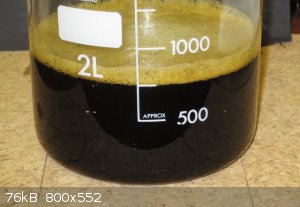
The initial filtrate from the NaOH extraction of the Sunleaves guano
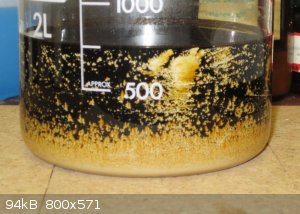
The off-white sodium urate deposited on cooling
Decant as much of the clear deep brown liquor as possible through a Whatman No1 filter paper in a Buchner funnel using very gentle suction finally
stir up the sodium urate and pour the slurry into the funnel too. Surprisingly it filters easily though slowly. Wash with a little water and then with
a little (about 40ml) of 95% ethanol (or methanol) and dry. The yield was 14.76g of cream coloured crude disodium urate.
Make the filtrate strongly acid with 30% hydrochloric acid (about 250ml) and heat to 90° C and cool slowly to get a more easily filterable
precipitate. When cold, filter at the pump through paper (Whatman No1 was used) and wash the cake with a little water and then alcohol or methanol.
Dry for 24 hours at about 35° C, yield was a further 12.12g of crude dark brown uric acid. (Further work in progress)
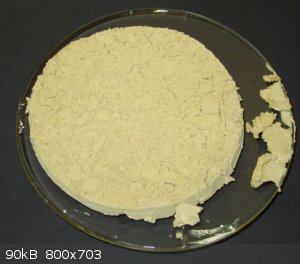
The sodium urate filter cake
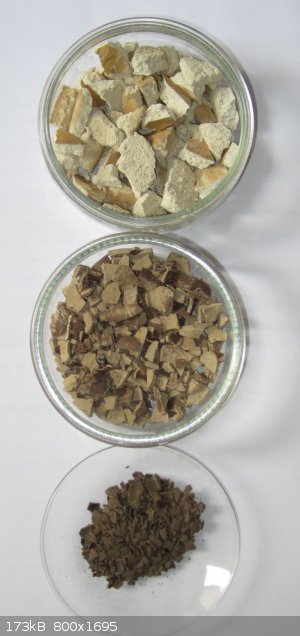
The filter cakes; the top is the dried sodium urate from Peruvian guano, the middle cake is the acid precipitated crude uric acid from Peruvian guano
and the bottom cake is the 2.98g of crude uric acid recovered from the swallow guano after the charcoal treatment.
Note 2; Gentle suction is required even with glass frits or filter papers to prevent clogging of the membrain. The cellulose in paper type filters
swell and soften under the influence of strong alkalis reducing their porosity and slowing the flow rate. Attempting to increase the flow rate by
increasing the pressure gradient across the filter simply results in collapse and puncture of the paper. Glass fibre filter papers are expensive but
can occasionally be purchased from Ebay at a reasonable price.
Uric acid info (mostly from McCrudden):
Solubility
Uric acid is very sparingly soluble about 0.006g per 100ml at 20° C; about 0.013g at 37° C and about 0.05g at 100° C.
Sodium hydrogen urate; about 0.087g per 100ml of water at 20° C and about 0.82g at 100° C
Disodium urate; 1.695g per 100ml of water at 18° C and 2.806g at 37° C. Surprisingly not figure for higher temperatures could be found. However,
even assuming a linear increase in solubility this would give 5.9g per 100ml at 90 C and 0.64 at 0 C. These figure should be take with care as an
excess of alkali is required to keep the disodium salt in solution, without this excess the salt hydrolyses to the monosodium salt which is much less
soluble.
I hope this is of use to someone else who fancies extracting something useful from shit!
|
|
|
Boffis
International Hazard
    
Posts: 1867
Registered: 1-5-2011
Member Is Offline
Mood: No Mood
|
|
I have done some more experimentation on the seabird guano and found that it is better to use more and more dilute sodium hydroxide solution to exract
the bird shit and then allow it to stand for 24 hrs before decanting through a Whatmans No40 or No3 filter paper (No3 is better because of higher wet
strength in 5% caustic soda). About 75-85% of the liquor can be filtered before the filter paper clogs, a second filter paper gets most of the
remainder particular if it is diluted a Little and again left to stand overnight.
The filter liquor is acidified with HCl and then the precipitated uric acid filtered off and recrystallised from a smaller volume of stronger NaOH
solution.
503g of guano gave 75g of crude cream coloured disodium urate and about 23g of crude uric by acidifying the filtrate. I´ll add the latter to the next
batch.
|
|
|
Boffis
International Hazard
    
Posts: 1867
Registered: 1-5-2011
Member Is Offline
Mood: No Mood
|
|
While sorting out a store room recently I came across my sack of Sunleaves Peruvian bird guano pellets and decided to pursue this topic further. In
particular the recovery of guanine. Since the posts I made above I have found references to the recovery of guanine (an aminoxanthine) having been
first discovered in bird guano in which it is reportedly abundant. The reference are a bit vague as to the method of extraction but given that guanine
is much more basic than uric acid immediately suggests a method.
So I tried leaching the guano pellets with dilute mineral acid (2M sulphuric acid and 2 to 5M hydrochloric acid). After some experimentation I have
been able to extract reasonable amounts of guanine and obtain it as a white microcrystalline power. Sulphuric acid gives a purer crude product because
it extracts less calcium which would otherwise ppt as calcium carbonate when the acid leachate is neutralised with sodium carbonate. However, the
hydrochloric acid leachate is rather more manageable and filters more easily. The calcium then has to be removed by a second leach and neutralisation
with a mixture of sodium carbonate and tetrasodium EDTA (from water softening powder). The overall yield is about the same but the HCl leach gives a
whiter product but this can be overcome by charcoal treatment of the acid leachate before re-precipitation.
An interesting feature I found was that after an acid extraction the guano residue is much easier to treat with caustic soda to extract the uric acid
and there is only a small loss in the amount of uric acid recovered.
I am currently working on a prepub. article with photos but I am away from home at present.
|
|
|
Sulaiman
International Hazard
    
Posts: 3699
Registered: 8-2-2015
Location: 3rd rock from the sun
Member Is Offline
|
|
Interesting coincidence :
Today I asked my daughter to Google what the white bit at the end of lizard poop is ;
(lots of it here)
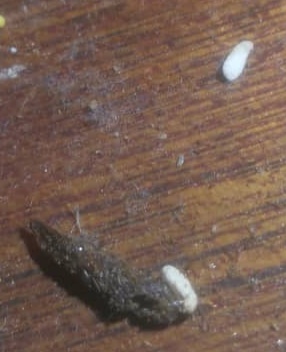
Apparently it is mostly crystalised uric acid.
CAUTION : Hobby Chemist, not Professional or even Amateur
|
|
|